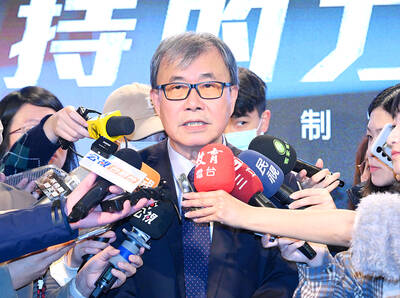Leaders of 16 nations from India to New Zealand inaugurated a new forum yesterday in ambitious efforts to chart a pan-Asian community -- a distant goal given rivalries festering among powers such as China and Japan.
The first East Asia Summit was the culmination of three days of meetings among the region's leaders in Kuala Lumpur, hosted by the 10-member ASEAN.
"It was very historic," Philippine President Gloria Macapagal Arroyo told reporters after the three-and-a-half-hour summit, noting that the group represents half the world's population and a third of its trade and income.
"The combined political will can do much to address issues that are of great interest to the region," she said.
The 10 ASEAN leaders joined with counterparts from Japan, China, India, South Korea, Australia and New Zealand. Russia attended as an observer, but there was no decision on its aspirations to be a full member.
Australian Prime Minister John Howard suggested the group stick with the current lineup for now: "It's a very manageable number around the table. If you make things too big, you lose the value."
The leaders pledged to cooperate in fighting bird flu, discuss security issues and meet every year, as sought by India.
India also is pushing for strong European-style integration aiming for a regionwide free trade area. However, no concrete action was taken toward that end.
A summit statement said merely that the group "could play a significant role in community-building in the region," but stressed its efforts wouldn't conflict with WTO talks on global free trade, currently under way in Hong Kong.
The Malaysia host, Prime Minister Abdullah Ahmad Badawi, said the leaders agreed that an "East Asia Community will be a reality in future as cooperation becomes stronger."
Japanese Prime Minister Junichiro Koizumi told other leaders that the East Asia Summit in coming years should "evolve into an opportunity for tackling concrete issues, not for just talk."
China and South Korea declined to hold one-on-one meetings with Japan during the summit. Both countries feel that Japan has not fully atoned for its brutal World War II past.
Indonesian Foreign Ministry spokesman Marty Natalegawa said continued tensions between Japan and China "would be inconsistent with the launching of an East Asian Community."
"Our hope has been that the two countries can find a way out of this situation," he said.
ASEAN comprises Brunei, Cambodia, Indonesia, Laos, Malaysia, Myanmar, Philippines, Singapore, Thailand and Vietnam.
Malaysia originally proposed the East Asia Summit as ASEAN plus Japan, China and South Korea, aiming to reduce US influence in the region.
But it took off only after the grouping evolved to include US allies Australia and New Zealand, with tacit approval of Washington, where officials have said they'll wait to see how the bloc's goals emerge before taking a firm stance on it.

STILL COMMITTED: The US opposes any forced change to the ‘status quo’ in the Strait, but also does not seek conflict, US Secretary of State Marco Rubio said US President Donald Trump’s administration released US$5.3 billion in previously frozen foreign aid, including US$870 million in security exemptions for programs in Taiwan, a list of exemptions reviewed by Reuters showed. Trump ordered a 90-day pause on foreign aid shortly after taking office on Jan. 20, halting funding for everything from programs that fight starvation and deadly diseases to providing shelters for millions of displaced people across the globe. US Secretary of State Marco Rubio, who has said that all foreign assistance must align with Trump’s “America First” priorities, issued waivers late last month on military aid to Israel and Egypt, the

‘UNITED FRONT’ FRONTS: Barring contact with Huaqiao and Jinan universities is needed to stop China targeting Taiwanese students, the education minister said Taiwan has blacklisted two Chinese universities from conducting academic exchange programs in the nation after reports that the institutes are arms of Beijing’s United Front Work Department, Minister of Education Cheng Ying-yao (鄭英耀) said in an exclusive interview with the Chinese-language Liberty Times (the Taipei Times’ sister paper) published yesterday. China’s Huaqiao University in Xiamen and Quanzhou, as well as Jinan University in Guangzhou, which have 600 and 1,500 Taiwanese on their rolls respectively, are under direct control of the Chinese government’s political warfare branch, Cheng said, citing reports by national security officials. A comprehensive ban on Taiwanese institutions collaborating or

France’s nuclear-powered aircraft carrier and accompanying warships were in the Philippines yesterday after holding combat drills with Philippine forces in the disputed South China Sea in a show of firepower that would likely antagonize China. The Charles de Gaulle on Friday docked at Subic Bay, a former US naval base northwest of Manila, for a break after more than two months of deployment in the Indo-Pacific region. The French carrier engaged with security allies for contingency readiness and to promote regional security, including with Philippine forces, navy ships and fighter jets. They held anti-submarine warfare drills and aerial combat training on Friday in

COMBAT READINESS: The military is reviewing weaponry, personnel resources, and mobilization and recovery forces to adjust defense strategies, the defense minister said The military has released a photograph of Minister of National Defense Wellington Koo (顧立雄) appearing to sit beside a US general during the annual Han Kuang military exercises on Friday last week in a historic first. In the photo, Koo, who was presiding over the drills with high-level officers, appears to be sitting next to US Marine Corps Major General Jay Bargeron, the director of strategic planning and policy of the US Indo-Pacific Command, although only Bargeron’s name tag is visible in the seat as “J5 Maj General.” It is the first time the military has released a photo of an active